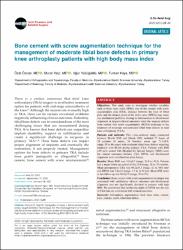| dc.contributor.author | Özcan, Özal | |
| dc.contributor.author | Yeşil, Murat | |
| dc.contributor.author | Yüzügüldü, Uğur | |
| dc.contributor.author | Kaya, Furkan | |
| dc.date.accessioned | 2021-05-05T22:14:04Z | |
| dc.date.available | 2021-05-05T22:14:04Z | |
| dc.date.issued | 2021 | |
| dc.identifier.issn | 2687-4784 | |
| dc.identifier.issn | 2687-4792 | |
| dc.identifier.uri | https://doi.org/10.5606/ehc.2021.76491 | |
| dc.identifier.uri | https://hdl.handle.net/20.500.12933/258 | |
| dc.description | WOS:000608440400006 | en_US |
| dc.description | PubMed: 33463415 | en_US |
| dc.description.abstract | Objectives: This study aims to investigate whether variables such as body mass index (BMI), size of the cement with screw augmentation area (CSA), distance between the base of tibial plate and the deepest point of the defect area (DPDA) may cause any mechanical problems leading to deterioration in tibiofemoral alignment or impact clinical outcomes when the surgeon utilizes bone cement with screw augmentation (BCSA) technique in the treatment of moderate non-contained tibial bone defects in total knee arthroplasty (TKA). Patients and methods: This cross-sectional study, conducted between March 2018 and March 2019, included 37 knees of 28 patients (4 males, 24 females; mean age 71.38.9; range, 55 to 86 years) with moderate tibial bone defects requiring treatment with BCSA during primary TKA. Patients with BMI >30 were scored with Hospital for Special Surgery (HSS) score for clinical outcomes; besides, CSA, DPDA, and tibiofemoral alignment were calculated on plain X-rays. Results: Mean BMI was 34.1 +/- 5.7 (range, 24.9 to 45.9). Patients had a mean follow-up period of 44 +/- 13.9 (range, 28 to 75) months. Mean postoperative CSA was 98.2 +/- 35.3 (range, 42 to 180) mm2 and DPDA was 7.4 +/- 2.6 (range, 3.5 to 12.9) mm. Mean HSS score at last follow-up was 88.0 +/- 7.5 (range, 71 to 97). Conclusion: Bone cement with screw augmentation technique was associated with satisfactory clinical outcomes and tibiofemoral alignment was not significantly deviated in patients with high BMI. We determined that neither the depth of DPDA nor the size of CSA had any correlation with clinical outcomes. | en_US |
| dc.language.iso | eng | en_US |
| dc.publisher | Turkish Joint Diseases Foundation | en_US |
| dc.rights | info:eu-repo/semantics/openAccess | en_US |
| dc.subject | Arthroplasty | en_US |
| dc.subject | augmentation | en_US |
| dc.subject | body mass index | en_US |
| dc.subject | cement | en_US |
| dc.subject | knee | en_US |
| dc.subject | primary | en_US |
| dc.subject | screw | en_US |
| dc.subject | tibial bone defect | en_US |
| dc.title | Bone cement with screw augmentation technique for the management of moderate tibial bone defects in primary knee arthroplasty patients with high body mass index | en_US |
| dc.type | article | en_US |
| dc.department | AFSÜ, Tıp Fakültesi, Cerrahi Tıp Bilimleri Bölümü, Ortopedi ve Travmatoloji Ana Bilim Dalı | en_US |
| dc.contributor.institutionauthor | Özcan, Özal | |
| dc.contributor.institutionauthor | Yeşil, Murat | |
| dc.contributor.institutionauthor | Yüzügüldü, Uğur | |
| dc.contributor.institutionauthor | Kaya, Furkan | |
| dc.identifier.doi | 10.5606/ehc.2021.76491 | |
| dc.identifier.volume | 32 | en_US |
| dc.identifier.issue | 1 | en_US |
| dc.identifier.startpage | 28 | en_US |
| dc.identifier.endpage | 34 | en_US |
| dc.relation.journal | Joint Diseases And Related Surgery | en_US |
| dc.relation.publicationcategory | Makale - Uluslararası Hakemli Dergi - Kurum Öğretim Elemanı | en_US |
















